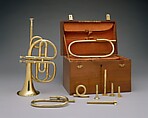Cornet à Pistons in B-flat
The cornet was invented in France in the 1820s as a valved version of the post horn. The instrument met immediate success and soon replaced keyed bugles as a favorite among audiences. This instrument has two valves of the type invented by the German Heinrich David Stölzel (1777 - 1844) in 1814 and which bear his name. Brass instruments with valves dating before 1840 are extremely rare, and this instrument, dated 1833, is one of the earliest surviving examples. Its two valves change the pitch of the instrument by lowering the pitch by a whole step and a half step respectively.
The instrument comes in its original mahogany box with the complete set of accessories: shank for Bb and A, crooks for Ab, G, and F, and two small couplers. Also included are two mouthpieces and a lyre which attaches to the rim (to hold a piece of music).
#Allan Dean plays Air Swiss 2004
-
Allan Dean plays Air Swiss 2004
-
9313. Cornet à Pistons in B-flat
Playlist
Due to rights restrictions, this image cannot be enlarged, viewed at full screen, or downloaded.

